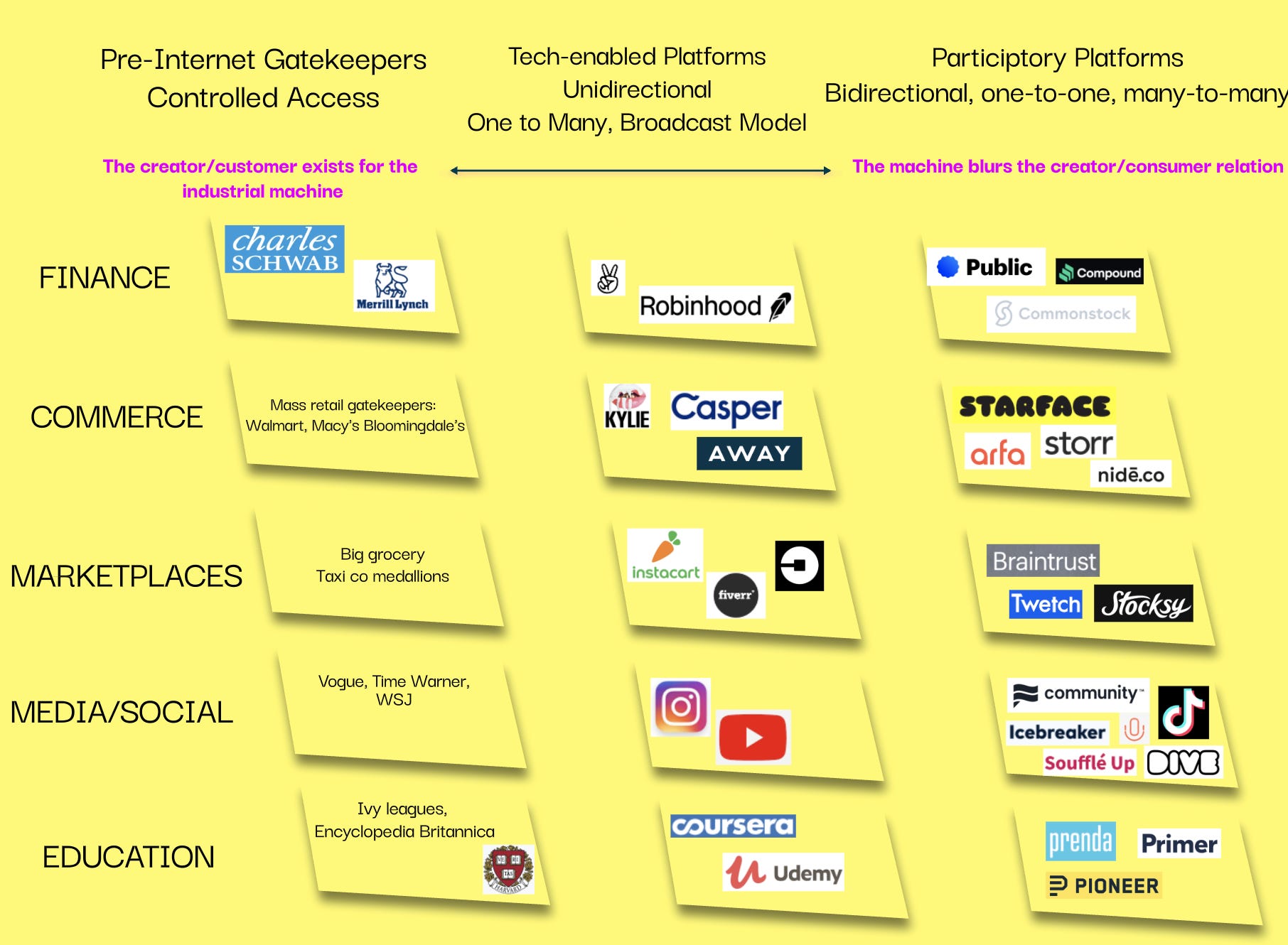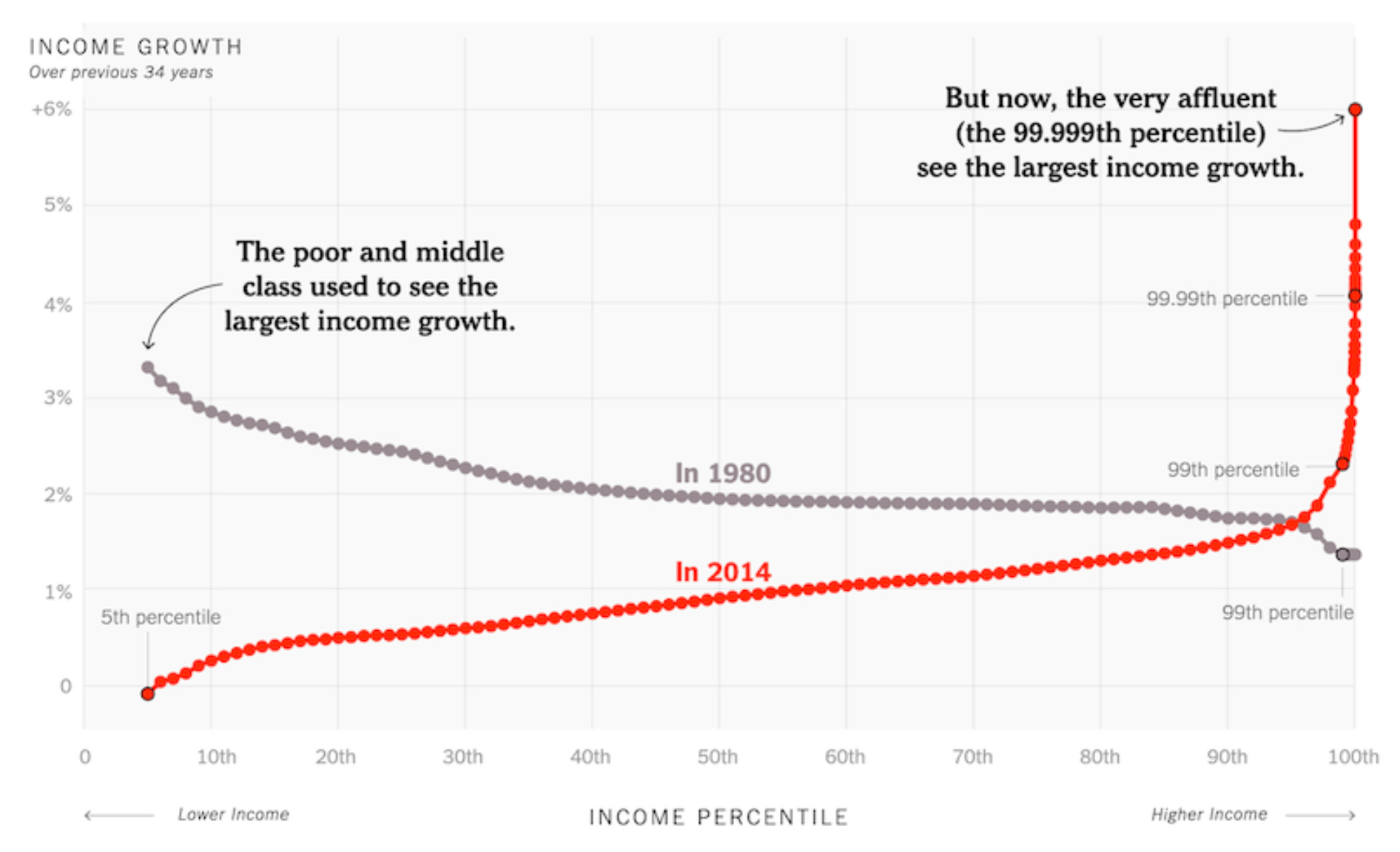 |
Welcome to the 131 subscribers since the last issue. I’m Sari Azout and this is the the 50th edition of Check your Pulse, a tech and startups newsletter designed to make you feel human. I try to make this one of the best emails you get each week. If you’ve been sent this email and you’re not a subscriber, you can join by clicking on this big red button below.
Happy Sunday friends,
Last week, I was a guest on the Unseen Unknown podcast, where I spoke to Jasmine about customer happiness, how brands need to rethink how they create/extract value, and the forthcoming participatory economy. It was a great conversation, and was the inspiration for today’s issue. Give it a listen!
Issue #48 on the participatory economy seemed to strike a chord with readers. It was the most popular issue to date, with over 25,000 views:
The problem with the subscription economy is there is no opportunity for fans to own assets, and further, subscription models don’t take into account the value that fans bring to their communities. While it’s still a nascent space, there are a few companies building in what I call “the participatory economy” — where fans participate in a creator’s success.
Zooming out, the participatory economy is a useful framework to understand how many industries are evolving.
 |
Before the Internet, information and power were controlled by gatekeepers that chose what to publish, produce, and distribute. The creator and the consumer were passive, and existed primarily to serve the industrial machine.
Tech-enabled Internet platforms removed many gatekeepers, but introduced new ones. Almost as quickly as social media emerged, influencers were born. With the advent of social media, brands were able to connect directly with their customers, spawning a direct-to-consumer retail movement. But being able to talk to your customer is very different than being able to talk with them. Instagram, YouTube, and Facebook have helped brands build a unidirectional relationship with their customers, but for all the talk of customer empowerment, the resulting relationship is still top down.
 |
👆🏽The Participatory economy can be understood as filling empowerment gaps and evolving our thinking of consumers as users to customers as people.
In the participatory economy, the creator is bidirectional because the customer is also a creator. The participation can happen in several ways:
The customer participates in the creation of the product
The company’s core product enables more people to participate, thereby democratizing the nodes of influence
The customer is aligned with the network’s upside and participates in the financial rewards
1. The customer participates in the creation of the product
Brands are increasingly empowering customers by making them partners in the brand-building process and letting them inform the product roadmap.
Emily Weiss, the founder of Glossier, credits the company’s success to their belief that every single person is an influencer. Arfa, founded by the former COO of Glossier, rewards a collective of customers co-piloting the development of the brand with 5% of profits. Nide, a French beauty brand, goes a step further — customers submit ideas and receive 500 euros if they have potential. If it gets enough community votes, customers earn 1,500 euros. And if the product is co-created, the customer receives 10% of sales.
2. The company’s core product enables more people to participate, thereby democratizing the nodes of influence
Storr is a marketplace where people buy from people instead of retailers. Public is a social investing app that lets you follow friends and domain experts, letting anyone share what they are investing in and their investing strategies. Startups upending traditional education can also be understood through the lens of the participatory economy. Schools have historically been about top-down instruction. But models like Prenda, Primer, and Pioneer empower learners and put them at the center. Everyone can participate in Pioneer, as long as they have a project and an internet connection:
A new wave of social networks is eschewing one-way broadcast in favor of two-way dialogue, with companies like Circle, Geneva, Mighty Networks, and Commsor increasingly powering the infrastructure for digital micro-communities. Ohana builds a community around your podcast, taking your podcast from a monologue to a dialogue. ForgeFiction allows fiction fans to create new original stories and fictional worlds. Ficto gives viewers the power to make narrative decisions. Souffle is a new Q&A app featuring debates on tech where all answers are temporarily anonymous, incentivizing people to vote for the best answer because of the merit of the argument, not because of who the author is.
In many ways TikTok is the best example of a participatory network. As noted by Eugene Wei, “The TikTok algorithm acts as a rapid, efficient market maker, connecting videos with the audiences they’re destined to delight. The algorithm allows this to happen without an explicit follower graph.” The removal of a follower graph prioritizes creativity and talent over reach, democraitizing and unlocking participation.
3. The customer is aligned with the network’s upside and participates in the financial rewards
Networks are slowly evolving from being intermediaries that take a commission on each transaction, causing participants to resent them, to being collectively owned platforms that reward contributors, making users more committed.
With more aligned incentives, networks that give their contributors economic incentives will grow faster.
Twetch is a Twitter alternative where you earn money for your content. Braintrust is the first user-controlled talent network that connects organizations with highly skilled tech talent. Delphia helps users monetize their data by turning it into an investment advantage
As participatory models emerge and evolve, they will drive growth in another area: tools that support them.
Some ideas:
Proof of Discovery for Fans: Media is still in search of a business model. Disappointment with ad-based models spawned the rise of subscription media. But it’s all but clear that charging $10 a month to give your audience more content is the right model. Almost nobody wants “more” — even of a newsletter they love. As Josh Spector said, “If your most valuable stuff doesn’t go in your paid product, then you’re essentially charging people for a product that’s worse than your free offering which isn’t a recipe to make people want to pay. And on the flip side, if your best stuff goes in your paid newsletter then your free version may struggle to attract the new people you need in order to keep growing.” But what if content was available for everyone to read and consume, but not for everyone to participate? What if subscribing to a creator on Substack didn’t unlock exclusive posts but instead generated a sense of membership and identity that you could brag about? When you support someone, what you really want to signal is “I found this creator”. In that case, creating systems that honor the labor of discovery and fandom seem like an area worth exploring. (This was inspired by Julian’s post, Proof of X, which is worth your time.)
Collaborative governance tools: As more companies look to involve customers in decision-making, they need better tooling. Tools like Canny and Upvoty enable roadmap sharing, but they are feedback, not co-creation tools. There is an opportunity to introduce better tooling with features such as built-in polling, voting, and rewards.
Carta for cooperative mechanics: What does a company like Carta or Pulley look like when you are distributing value across tens of thousands of people, and reacting in real-time to contributions and other variables? There are token-based apps, like Props and Roll, but I continue to think the UX is suboptimal.
A paradoxical truth in business is that most companies spend little time focused on their customers. The beauty of the participatory economy is that it’s not only about what makes sense for publishers, advertisers, creators, teachers, etc… but also listening to the people on the other side (students, fans, readers, shoppers) and honoring them as people, not users.
🙏🏽
Sari
 |
 |
Michael Jordan once turned down $100 million for just two hours of his time: “I brought [Michael Jordan] a deal three years ago for $100 million,” Falk said. “And all he had to do was, other than giving his name and likeness, make one two-hour appearance to announce the deal and he turned it down. And God bless him. He’s been so successful, it gives him an opportunity to do whatever the hell he wants or not to do things he doesn’t want. And I really admire that. He’s very, very selective in the things that he wants to be involved in.” ⏳
I enjoyed Jack Dorsey’s interview on The Daily, where he acknowledges some of Twitter’s early mistakes: “The disciplines that we were lacking in the company in the early days, that I wish we would have understood and hired for were a game theorist to just really understand the ramifications of tiny decisions that we make, such as what happens with retweet versus retweet with comment and what happens when you put a count next to a like button? Without this expertise, Twitter built incentives into the app that encouraged users and media outlets to write tweets and headlines that appealed to sensationalism instead of accuracy.” 🎙️
I know the bar is low but Levain cookies coming to groceries is the best thing to happen in 2020. 🍪
An incredible breakdown of the fashion industry. In April, clothing sales fell 79 percent in the United States, the largest dive on record. Purchases of sweatpants, though, were up 80 percent. 🤸🏾♂️
 |
A curated list of websites that spark joy. 🎊
This, via Byrne Hobart 👇🏽💯
 |
 |
In Shopify and the Hard Thing About Easy Things, Packy asks why, if e-commerce is blowing up, there are so few big DTC exits. The answer: If everyone can do something, there’s no advantage to doing it, but you still have to do it anyway just to keep up. By making Direct-to-Consumer (“DTC”) easier, software like Shopify increases entropy and lowers the probability that any specific company will generate sustained profits. 🛒
Airport is a directory of pre-launch, test-flight stage consumer apps. ✈️
Marie Dolle writes an extensive piece on newsletter monetization strategies, with some commentary by yours truly. 📩
A thought-provoking post by Adam Keesling on Intangible Assets and how we have shifted from an industrial economy to an information economy, yet the investments in information assets aren’t recognized in financial statements. How much is Lululemon’s brand worth? How much are Facebook’s network effects worth? How much is Costco’s customer loyalty (earned through investing in lower prices) worth? None of these appear on the financial statements, but they are core value drivers for these businesses. 💭
 |
 |
If you’re wondering who’s behind this newsletter:
My name is Sari Azout. I am a design-thinker, strategist, and early stage startup investor at Level Ventures and Rokk3r. My mission is to bring more humanity and creativity to technology and business.
Want more?
Follow me on Twitter, Medium, and Instagram.
Know a founder i should meet?
Drop me a note at sari@level.vc
If you're enjoying this newsletter, I'd love it if you shared it with a friend or two. You can send them here to sign up.
And if you come across anything interesting this week, send it my way! I love finding new things to read through members of this newsletter.
Thanks for being here!


